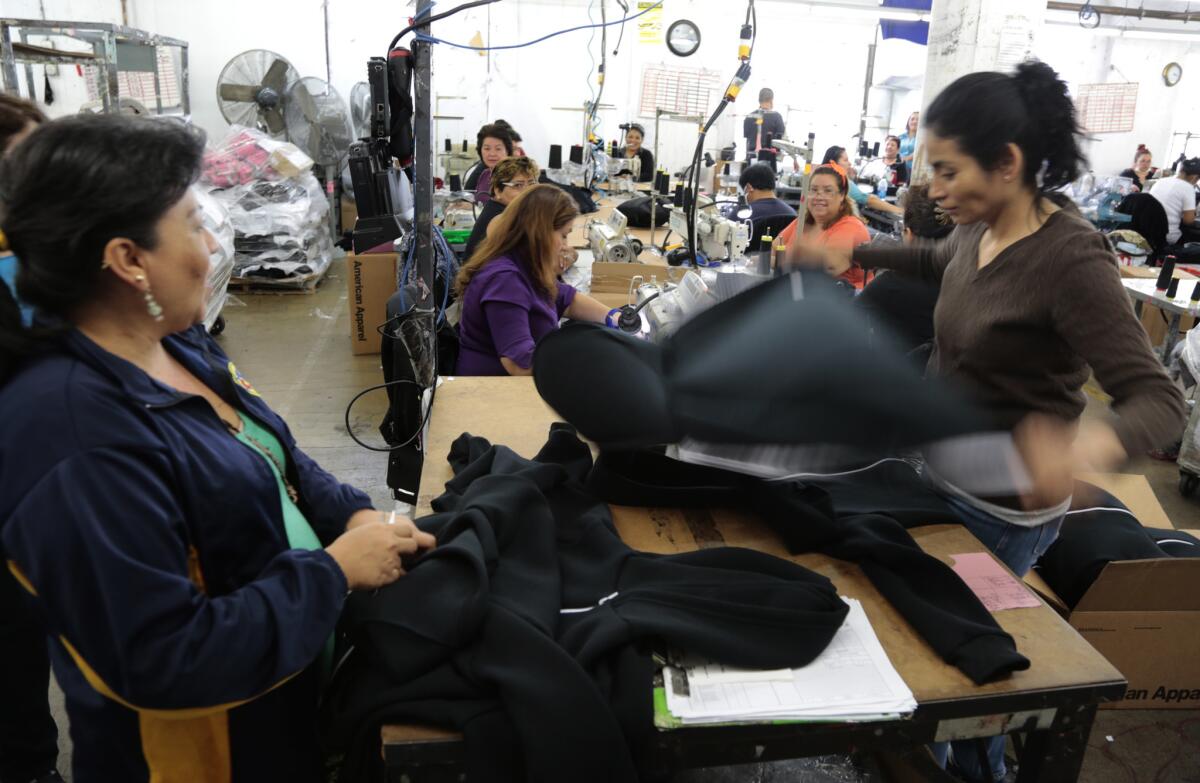American Apparel lays off hundreds of workers and considers outsourcing some manufacturing

American Apparel is laying off workers as it revamps its production process. Above, employees are seen at the company’s downtown Los Angeles headquarters and manfacturing center.
- Share via
American Apparel is laying off hundreds of workers and retooling its production process — and may start making some of its clothing outside Los Angeles.
The downtown L.A. company began layoffs last week. So far, about 500 local employees have lost their jobs, said Nativo Lopez, a senior advisor with Hermandad Mexicana, which is helping workers in unionizing efforts. The company has about 4,600 employees in Southern California.
American Apparel emerged from bankruptcy in February and has been trying to move past a tumultuous two years that saw the ouster of founder Dov Charney, store closures and massive fire sales to clear unsold merchandise.
In a letter to employees last week, Chief Executive Paula Schneider blamed the workforce reduction on a “redesign of our production process” that will include making fewer garments throughout the year to cut down on inventory that eventually has to be discounted.
Schneider also hinted that the manufacturing of more complicated pieces, such as jeans, could soon be outsourced to a third-party company — though she stressed that the products “will still be American-made.”
Manufacturing all of its colorful leggings, knit tops and accessories in Los Angeles has been a cornerstone of American Apparel, set in place years ago by Charney, a staunch immigration and fair wages advocate. After his firing, the company has been moving away from its roots by distancing itself from its outspoken former chief executive, toning down its racy billboards and now rethinking one of its fundamental tenets about how and where its products are made.
The company said only a fraction of its garments would potentially be outsourced, according to last week’s letter that was obtained by The Times.
But analysts said this was probably the company’s first step in leaving Los Angeles, at least when it comes to manufacturing.
“They’re headed out of Dodge,” said Lloyd Greif, chief executive of Los Angeles investment banking firm Greif & Co. “They are going to outsource all garments. It’s only a matter of time.”
American Apparel appears to be dropping the bad news a little at a time, he said, to gauge public opinion and also to prevent a worker revolt.
“They might be kind of testing the waters to see what the market reaction is,” Greif said.
So far, the company will only say that it is considering farming out the making of complicated garments that take a lot of labor but comprise a small slice of the company’s business.
For instance, about 80% of the garments made by American Apparel last year were basics such as T-shirts, while 20% were more complex pieces such as denim. However, employees were split about 50-50 between the two categories, the letter said.
That mismatch between workers and manufacturing is an inefficiency that needs to be addressed as part of the company’s turnaround efforts, Schneider said.
For now, American Apparel will probably outsource manufacturing to a cheaper part of the country, such as the South, analysts said. Eventually, the company may well move much of its manufacturing overseas.
The main problem is that it’s difficult to pay workers decent wages — Charney used to boast that his sewers were paid $12 an hour on average — and still make money while selling pricey $30 T-shirts. Complicating matters is a hotly contested retail landscape full of fast-fashion chains that make their clothes abroad and sell them for a fraction of American Apparel’s prices.
“There’s no reason why American Apparel has to be made in America,” Greif said. “It can be designed in America, but cut and stitched somewhere else.”
When American Apparel first began manufacturing from its cavernous coral pink warehouse near the Arts District, it was heralded as a bold move that defied conventional thinking that U.S. retailers had to outsource to Asia to make their goods. Charney was championed as a visionary thinker, bringing thousands of jobs to downtown L.A. and a belief that “Made in America” was attainable.
On Tuesday, Charney characterized the latest moves as a betrayal of American Apparel’s foundation. He was ousted as chairman and chief executive after an investigation uncovered allegations of misuse of company funds and inappropriate behavior with employees.
“They are doing exactly what American Apparel fought against,” Charney said. He said he had always resisted “outsourcing and searching for ways to pay people less money.”
American Apparel declined to comment.
In the letter, Schneider said shaking up the production process came after “months of careful and rigorous review.”
“We have streamlined the number of items we display in each of our stores,” she wrote. “Earlier this year, we closed a number of stores to focus on our best-selling locations.”
Lopez, the labor organizer, said the general mood among workers is “doom and gloom.”
Laid-off employees were given a severance package of two months’ pay. They also were offered an additional $800 if they waived their right to file any claims against the company, Lopez said.
Since it emerged from Chapter 11, the company has appointed new board members, including Susan Davidson, chief executive of Zac Posen and fashion boutique Scoop.
Twitter: @ByShanLi
More to Read
Inside the business of entertainment
The Wide Shot brings you news, analysis and insights on everything from streaming wars to production — and what it all means for the future.
You may occasionally receive promotional content from the Los Angeles Times.











